More solar energy should mean more metal roofs
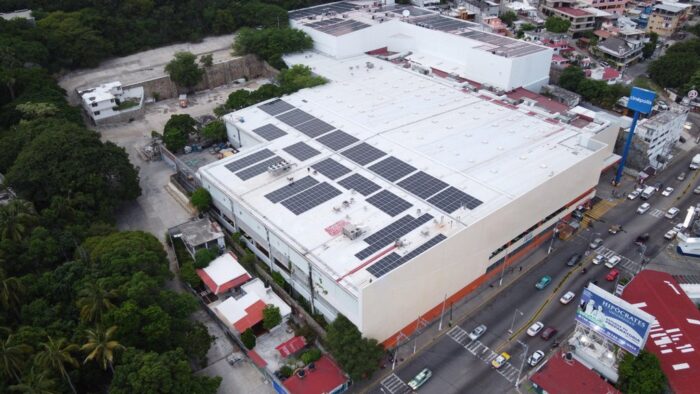
Solar panels and metal roofing make a great pair for many reasons. We are hosting an S-5! Webinar on Feb. 19 that touches on this topic in more depth, and will explain how solar installers can best take advantage of metal roofs. In preparation for that webinar, let’s run through some of the finer points of why metal roofing is a perfect application for solar.
Solar is becoming a dominant source of electricity.
Solar energy consistently ranks as the No. 1 source of new generating capacity added in the United States. According to the most recent data from the Federal Energy Regulatory Commission (FERC), analyzed by the SUN DAY Campaign, solar comprised 81.5% of new U.S. generating capacity in 2024 – 50% more than the solar capacity added in 2023 – and was the largest source of new capacity for 16 straight months.
And FERC data doesn’t even include small-scale rooftop solar systems: “If that is factored in, within three years, total U.S. solar capacity (i.e., small-scale plus utility-scale) could surpass 320-GW.”
Point being: If solar is the future, we should be getting ready to install it everywhere it makes sense.
Rooftops are the most ideal location for solar panels.
Despite the utility-scale stats just cited, ideal sites for large-scale solar power plants are dwindling. Also, solar is often a contentious not-in-my-backyard issue in town hall meetings. Luckily, rooftops hold plenty of solar potential.
Analysts at the Energy Department’s National Renewable Energy Laboratory (NREL) estimate the “technical potential” for rooftop PV systems in the U.S. is 1,118 GW of capacity and 1,432 TWh of annual energy generation, equivalent to 39% of the nation’s electricity sales. That study was done in 2016, and the values are based on a 16% efficient solar module. Bump that to modules of 20% efficiency, and the 39% grows to 48.75% of the U.S. annual electricity demand value.
Rooftops are also obviously a more efficient use of space. Panels directly serve building loads, cutting down the need for expensive transmission and distribution infrastructure.
To sum up so far: Solar is the future of energy. We are running out of land. Rooftops are the best spot to put solar panels anyway.
Metal roofs last longer than solar panels.
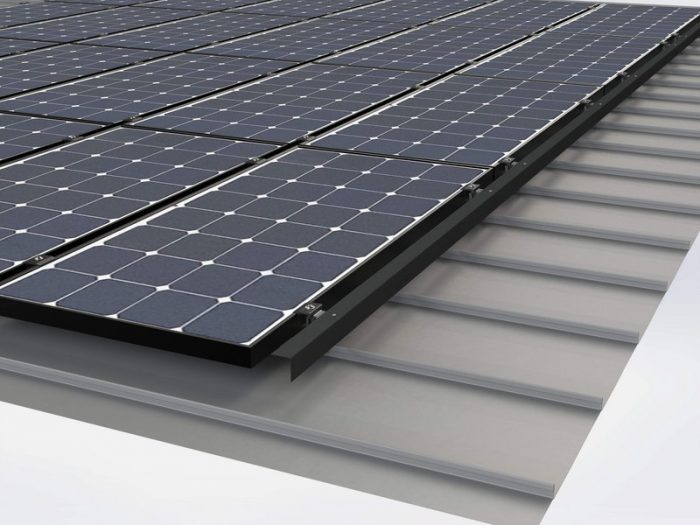
Solar energy investments are often questioned or delayed because of roofing. Install a PV system on too old of a roof, and then it’s a whole thing to remove it and reattach. Heck, even installing solar panels with a new roof will lead to an inconvenience down the line because solar panels outlive most roof types.
All except metal roofs.
Metal is highly inert, and the service life of a metal roof is measured in decades instead of years, making it a place to attach a 25+ year investment. A recent study published by the Metal Construction Association found that the service life of a properly designed and constructed metallic coated steel roof is in the range of 70 years in most non-coastal U.S. environments.
Metal roofs are structurally sound for solar attachment.
Lifetime isn’t the only metric that makes metal roofing a good match for solar. According to the Metal Construction Association, metal roofing has inherent aspects that make it compelling as the perfect platform for mounting a PV system including geometry, strength, sustainability and durability to wind, hail, rain and snow.
Metal roofing, in particular standing seam metal roofing, is known for its exceptional performance in high-wind conditions, due in part to its attachment methods and interlocking installation where roof panels are overlapped and attached to the structure of the building, reducing the ability of wind to disrupt the panels. Metal roofing lends itself to high-wind areas because it can be engineered easily to withstand nearly any uplift force within the design stage.
Consider the before (top of article) and after photos (below) from the metal roof solar project at Grupo Comercial Chedraui’s Acapulco store in the wake of cat 5 Hurricane Otis. This grocery superstore chain operates nearly 350 stores throughout Mexico, and the solar metal roof of its Acapulco store was one of the few that survived the onslaught of wind and rain, attributed to the clamp attachment securing the solar array to the roof, which provided a stronger attachment and may have saved the roof and the entire infrastructure.
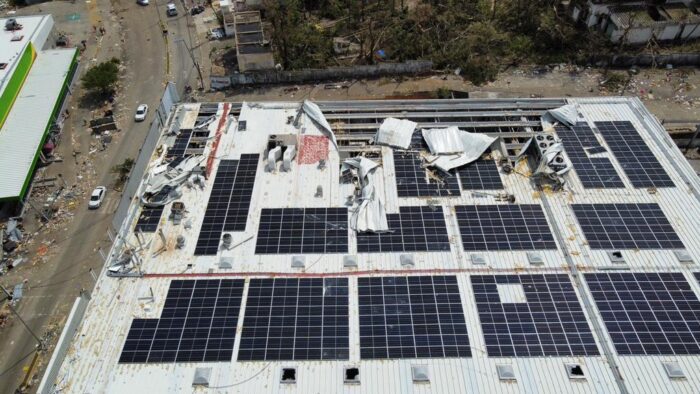
Photos of the site taken post-hurricane clearly indicate the vast majority of roof damage was to areas of the roof without solar installed. This is evident, even in the higher-pressure edge roof zones, where the roofing panels along the edge zones, under the solar modules, were not damaged while the nearby bare roofing was blown off. The MX Mini clamps together with the PVKIT solar mountings by S-5! were installed to secure the solar modules to the metal roof, but the clamps performed a secondary function as wind clamps.
Considering how the wind causes uplift forces when approaching and blowing across the solar array installed on the roof, the dynamics of the wind forces shifted from direct pressure on the roof to split pressure on both the roof and the solar modules. The metal roof seams were strengthened from the installation of the clamps to resist uplift pressures on the roof and met the challenge to secure the solar modules to the building, preventing wind uplift forces from tearing them off the building and preserving the roof.
For more on the solar attachment attributes of specific metal roof types, check out this MCA white paper.
FM 4478 | Also consider FM 4478, a new standard that certifies the combination of a solar panel + mounts and racking + the metal roof itself. While UL is focused squarely on product testing, FM is an insurance company. The standards they create are not the same as those required for permitting. But as an insurance company, FM has skin in the game, and its standards are stringent and widely accepted by code officials, despite being driven by insurance and not building code.
“In a vacuum, it is a better standard,” says Mark Gies with S-5! “FM 4478 is essentially a bullet proof system.” FM Approvals listed the Ensolro System to FM 4478 in 2024, which includes the S-5! PVKIT HUR 2.0 rail-less, direct-attach, solar mounting solution for metal roofs. It can withstand wind uplift forces of up to 150 psf in high-wind and hurricane zones.
At last check, RoofNav lists 365 roof assemblies with rigid PV panels. Of those, 344 have single ply roof covers, and 21 have standing seam roof covers. There are 4 PV modules Approved.
FM 4478 is a tough standard to meet, however, considering every combination of roofing, racking, attachment and module has to be listed. Being driven by insurance means the listed systems are much more robust too, and thus more expensive. But you’re more likely to get the cheapest insurance rate if you install an FM approved system. And again keeping in mind that longer-term view (climate change and the increase of extreme weather), pursuing FM 4478 roofing + solar systems might be worth the investment.
“We evaluate and list products and systems meeting our Approval requirements,” explains Phillip J. Smith, PE , VP, Manager, Building Materials, for FM Approvals. “There are certainly long-term benefits in using an Approved system that will help protect your building from different perils and help your business be more resilient.”
Metal roofing has environmental benefits too.
Solar panels and metal roofs also complement each other in terms of sustainability goals. Steel is not only 100% recyclable but is also the most recycled construction material in the world at nearly 85%. Steel also is not a fossil fuel-based product. The longer service life is an argument for sustainability too.
Given all of that, prioritizing metal roofs to accommodate more solar panels seems like a no-brainer. What is stopping us?
Metal roofs cost more. But …
A metal roof is typically significantly more expensive than a TPO roof in commercial roofing. The cost could range anywhere from 20% to 50% higher per square foot, depending on the specific metal type and installation complexity.
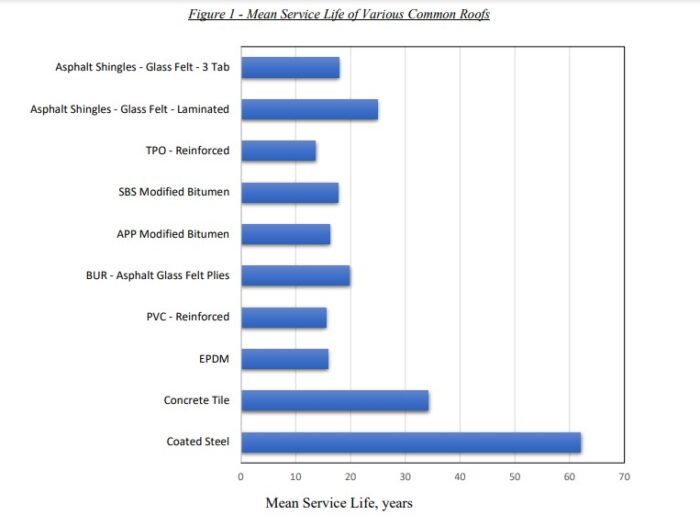
The long-term, lifecycle analysis is crucial. The argument from the Metal Construction Association is that while metal roof systems may have higher initial costs than some other roofing materials, the costs of mounting solar arrays can also be reduced, offsetting the premium cost of the roof. According to the MCA, “spending a few more dollars for a metal roof could result in 10-15% savings on the solar PV system installation. On larger commercial projects, the economies of scale further increase the savings.”
Factoring in the cost of a roof replacement and the labor costs of dismantling and reinstalling the solar PV array following roof replacement is a huge factor, especially considering the growing necessity for those solar panels.


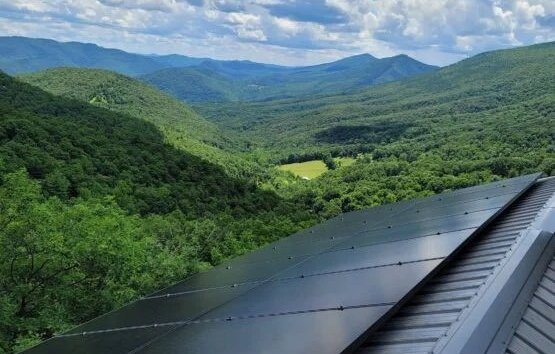

Comments are closed here.